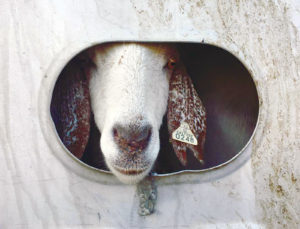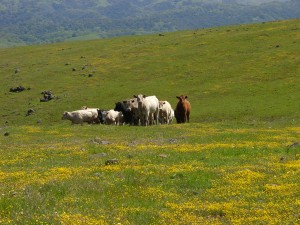Both the article “Range of Possibilities” by Kelly Cash, followed up by the pro-livestock piece “Public Lands Need Cattle to Meet Conservation Goals,” by Sheila Barry imply that livestock production is an overall positive activity for California public lands and wildlife.
I have been following livestock issues for decades and heard many times all the assertions and arguments for why livestock production is a “benefit.” Usually the presumed benefits—if they are real in the first place–can only be realized in small areas and/or result in excessive widespread collateral damage to wildlife, soils, water, and vegetation.
For instance the idea that grazing can reduce wildfires usually requires denuding a landscape so severely it looks like a putting green. However at that point the grass is so short there is little for other wildlife to eat, and no hiding cover for small mammals or birds to avoid predators, not to mention the high density of livestock needed to accomplish this feat compacts soils reducing water infiltration.
While one may point to an occasional situation where livestock production may benefit a particular species in unusual circumstances, on the whole livestock-induced habitat changes are involved in the imperilment of hundreds of species. Notwithstanding that there are often multiple factors contributing to any species demise, one can frequently draw a direct link to livestock production as a major factor in many California species decline.
For instance, one reason cited for sage grouse population decline across its range is predation. However, one must ask why are the sage grouse vulnerable to predators? A recent study concluded that a minimum of 7 inches and ideally at least 10 inches of residual grass is needed for grouse to hide from predators. Yet in much of the sage grouse’s habitat, livestock grazing has reduced grass height far below these limits.
Besides sage grouse, many other species have suffered population declines due to livestock induced habitat changes or merely forage competition. For instance, the Mohave ground squirrel has suffered from the spread of annual grasses and decline in shrubs in its habitat in part due to livestock grazing. And in times of drought, the ground squirrel endures forage competition with livestock. The same competition with livestock for scarce green vegetation is also a factor in the decline of the desert tortoise.
Livestock trampling and cropping of vegetation is the primary cause of degradation of the lush riparian corridors along rivers and stream that are critical habitat to some 70-80 percent of the state’s wildlife, harming species like the Least Bell’s Vireo, Southwest Willow Flycatcher and Yellow Cuckoo, plus amphibians like the Oregon spotted frog and fish like the Lahontan cutthroat trout.
The diversion of water from rivers to grow irrigated hay, alfalfa and other livestock forage crops, as well as the dams that block rivers to create irrigation water storage, are both detrimental to aquatic ecosystems and many fish, such as salmon and steelhead. And despite swimming pools, golf courses, and large urban centers, the largest consumer of water in California is irrigated livestock forage. Even most grass-fed beef cattle rely to some extent on hay or irrigated pasture for their sustenance.
The poisoning of predators like coyotes and the now extirpated wolf as well as many ground squirrels is yet another well-documented impact of livestock production.
Livestock are also one of the major sources of water pollution on many public as well as private rangelands.
Lest we forget, livestock are among the main sources of methane, a major greenhouse gas contributing to global climate change.
This is only the beginning of a litany of negative effects of livestock production.
Nearly all of the examples of improved conditions for the land, including the Bay Nature piece, focus on a handful of particularly motivated ranchers who often have outside financial resources that permit them to REDUCE livestock impacts. A reduction in impacts is not the same as no impact.
For example in the “Range of Possibilities” article, the author noted that “Point Blue documented a 72 percent increase in where native perennial grasses were found on Tom Kat Ranch after the landowners changed their cattle grazing to give the land more rest.” The article then notes this resulted in a benefit for wildlife and plants, as well as greater water infiltration.
However, what they documented was a reduction (i.e. more rest from livestock) in livestock grazing impacts.
This raises the natural question, how much greater improvement might we see if there were no livestock grazing? In the example mentioned above, the proponents of ranching provide no comparison with a non-grazed pasture where you might find even greater habitat recovery for birds and wildlife, and more water infiltration.
It’s like saying that someone who smoked three packs of cigarettes a day and reduced their smoking to one pack a day saw an “improvement” in their health. While the finding that smoking less cigarettes does improve one’s health, it is disingenuous to leave a person with the impression that cigarettes are the reason for improvement in health or to neglect to raise the notion that no cigarettes might lead to even greater health and financial benefits. Similarly in most situations, the removal of livestock provides the greatest benefits to wildlife and the land.
The pro-livestock advocates featured in these articles used similar selective information to create the illusion that livestock production is a positive influence upon California’s landscape.
To give one example of how the statements in these articles consist of partial truth, take Sheila Barry’s comment that “Not a single documented plant or animal in California has gone extinct due to livestock grazing.”
In reality there have been very few species extinctions in the entire West. Only one California vertebrate, the Santa Barbara song sparrow, is completely extinct, though a number of species like the grizzly bear and wolf have been extirpated from California. So her statement without context leaves one with the impression that livestock production has had few impacts on native species.
Nevertheless, there are literally hundreds upon hundreds of plants and animals that are declining in numbers, and in jeopardy due to direct and indirect damage from livestock production across the West, including in California.
Even where there are documented benefits of livestock for a species, it is usually due to the overall negative losses of suitable habitat resulting from on-going and past livestock production. For instance, Sheila Barry mentions the California red-legged frog as a species benefiting from livestock water troughs and stock ponds.
However, the reason frogs must resort to these artificial features like stock ponds is because so much of their native wetland and riparian habitat has been degraded, diminished, and destroyed by livestock. Livestock trampling of riparian areas has damaged much of the native streamside cover used by the frogs to hide from predators, as well as reducing habitat for the insects that are the primary food of this amphibian. Loss of riparian vegetation and stream-side vegetation also results in higher water temperatures that can benefit non-native bull frogs which compete with and even eat the red-legged frog. The soil erosion resulting from livestock fills streams with sediments, reducing the depth of pool habitat to the detriment of the frog. Bank trampling reduces the undercut channels that frogs use to hide from predators. The deposition of manure and urine by streams can cause nutrition loading which can increase bacteria harmful to frogs. Livestock trampling of egg masses and larvae is also a problem in some instances.
In the absence of livestock-caused habitat degradation, the red-legged frog might not have to resort to human built features like stock ponds for its survival.
Finding a few circumstances where livestock benefits the environment is somewhat analogous to suggesting that radiation benefits human health because it can be used to kill cancer cells, and then implying radiation is a good thing for people by ignoring the collateral damage to the body.
One of the “benefits” currently in vogue is that idea that grass-fed beef can reduce global warming through carbon sequestration. The theory is that grazing grasses causes them to produce more carbon biomass (roots) which is stored in the soil. However, this only occurs if there is significant water for additional plant growth—a problem in arid western rangelands.
Plus the accumulation of carbon in soils—if it even occurs—is slow, taking decades or centuries. And if grazing causes any soil erosion or replacement of native perennial grasses with annual exotics—a common problem in California ranchlands, there is a net loss of carbon. Many studies in arid rangelands also demonstrate greater soil carbon accumulation where livestock grazing is completely excluded.
Furthermore, the slow accumulation of soil carbon – again, if it even occurs — with livestock grazing must be balanced against the current methane emissions resulting from cattle during digestion. Because grass is more difficult to digest and lower in nutrient content than other forage like corn fed to CAFO livestock, grass-fed animals require additional months of growth before they reach slaughter weights, emitting methane the entire time.
This is not to suggest CAFO-produced livestock are better, but to note that grass-fed beef has its own set of environmental problems.
While better livestock management might be a worthwhile goal on private rangelands, it is questionable if any livestock production is worth the costs to public resources on public rangelands. If full cost accounting is done of all the ecological as well as economic costs of subsidized livestock grazing, it is clear that livestock production has no place on our public rangelands.
George Wuerthner is an ecologist who has studied grazing issues for decades, and the author of Welfare Ranching: The Subsidized Destruction of the American West.



